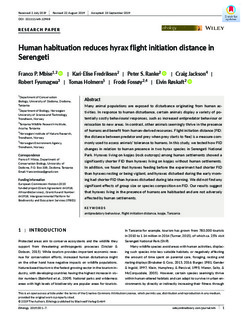| dc.contributor.author | Mbise, Franco Peniel | |
| dc.contributor.author | Fredriksen, Kari-Elise | |
| dc.contributor.author | Ranke, Peter Sjolte | |
| dc.contributor.author | Jackson, Craig Ryan | |
| dc.contributor.author | Fyumagwa, Robert D. | |
| dc.contributor.author | Holmern, Tomas | |
| dc.contributor.author | Fossøy, Frode | |
| dc.contributor.author | Røskaft, Eivin | |
| dc.date.accessioned | 2020-01-20T07:23:22Z | |
| dc.date.available | 2020-01-20T07:23:22Z | |
| dc.date.created | 2019-10-18T08:14:09Z | |
| dc.date.issued | 2019 | |
| dc.identifier.citation | Ethology. 2019, 00 . | nb_NO |
| dc.identifier.issn | 0179-1613 | |
| dc.identifier.uri | http://hdl.handle.net/11250/2636895 | |
| dc.description.abstract | Many animal populations are exposed to disturbance originating from human activities. In response to human disturbance, certain animals display a variety of potentially costly behavioural responses, such as increased antipredator behaviour or relocation to new areas. In contrast, other animals seemingly thrive in the presence of humans and benefit from human‐derived resources. Flight initiation distance (FID: the distance between predator and prey when prey starts to flee) is a measure commonly used to assess animals’ tolerance to humans. In this study, we tested how FID changes in relation to human presence in two hyrax species in Serengeti National Park. Hyraxes living on kopjes (rock outcrops) among human settlements showed a significantly shorter FID than hyraxes living on kopjes without human settlements. In addition, we found that hyraxes feeding before the experiment had shorter FID than hyraxes resting or being vigilant, and hyraxes disturbed during the early morning had shorter FID than hyraxes disturbed during late morning. We did not find any significant effects of group size or species composition on FID. Our results suggest that hyraxes living in the presence of humans are habituated and are not adversely affected by human settlements. | nb_NO |
| dc.language.iso | eng | nb_NO |
| dc.publisher | Blackwell Verlag GmbH | nb_NO |
| dc.rights | Navngivelse 4.0 Internasjonal | * |
| dc.rights.uri | http://creativecommons.org/licenses/by/4.0/deed.no | * |
| dc.title | Human habituation reduces hyrax flight initiation distance in Serengeti | nb_NO |
| dc.type | Journal article | nb_NO |
| dc.type | Peer reviewed | nb_NO |
| dc.description.version | publishedVersion | nb_NO |
| dc.source.pagenumber | 7 | nb_NO |
| dc.source.volume | 00 | nb_NO |
| dc.source.journal | Ethology | nb_NO |
| dc.identifier.doi | 10.1111/eth.12968 | |
| dc.identifier.cristin | 1738222 | |
| dc.relation.project | EC/H2020/EC/H2020 641918 (AFRICANBIOSERVICES) | nb_NO |
| dc.relation.project | EC/H2020/EC/H2020 641918 (AfricanBioServices) | nb_NO |
| dc.description.localcode | © 2019 The Authors. Ethology published by Blackwell Verlag GmbH This is an open access article under the terms of the Creative Commons Attribution License, which permits use, distribution and reproduction in any medium, provided the original work is properly cited. | nb_NO |
| cristin.unitcode | 194,66,10,0 | |
| cristin.unitname | Institutt for biologi | |
| cristin.ispublished | true | |
| cristin.fulltext | original | |
| cristin.qualitycode | 1 | |

